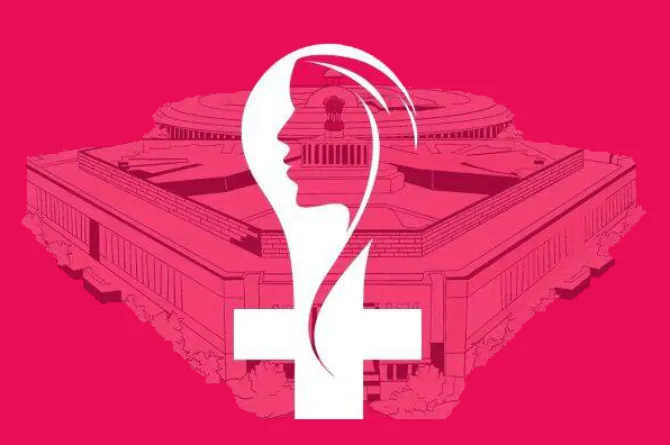
The Indian Parliament has recently witnessed a historic moment as both houses have almost unanimously passed the long-awaited Women's Reservation Bill with support from Members of Parliament (MPs) across all party lines in a special session held in September. More significantly, the women leaders of the country spearheaded the debate on the Bill in Parliament. With the presidential assent, the women's reservation became a law officially called “Nari Shakti Vandan Adhiniyam, 2023”.
The legislation will come into force once the census is carried out and the delimitation of the constituencies is done on the basis of which the seat allocation for women will be performed.
The Nari Shakti Vandan Adhiniyam legislation, which is the 106th Constitutional Amendment Act, mandates the reservation of one-third of the total seats in the Lok Sabha, the state legislative assemblies and the Legislative Assembly of the National Capital Territory of Delhi for women. This provision would also cover the seats reserved for the Scheduled Castes (SCs) and the Scheduled Tribes (STs) in the Lok Sabha and the Vidhan Sabhas in the states. The legislation will come into force once the census is carried out and the delimitation of the constituencies is done on the basis of which the seat allocation for women will be performed. This reservation will be in effect for 15 years, but it can continue until a Parliament-enacted law specifies otherwise. Also, the allocation of seats designated for women will undergo rotation following each delimitation, as specified by a law enacted by the Parliament.
Historical overview
Though the Constituent Assembly provided reserved seats for the SCs and STs, there was no provision for the reservation of seats for women in electoral politics at the time of the drafting the Indian Constitution. The legislation for the reservation of at least one-third of seats for women in local self-government, i.e., at the municipal level and panchayats, was ushered in by the 73rd and 74th Amendment Acts of 1992 in India. Since then, the need for the reservation of seats for women in the Parliament and the state legislative assemblies has been greatly deliberated upon in the last three decades. Earlier, attempts were also made to initiate a legislation in this regard. Though the percentage of women legislators has relatively increased over time, it remained within 15 percent in the Parliament and tentatively around 10 percent in the state legislative assemblies respectively. Over the years, a number of studies and reports in this domain have reinforced the need for the reservation of seats for women in the national- and state-level legislative structures in India. For instance, the National Policy for the Empowerment of Women (2001) and the Report on the Status of Women in India (2015) emphasised the need for women's reservation in the Parliament and state assemblies. Attempts to bring in the legislation for ensuring the reservation of seats for women have been made in 1996, 1998, 1999 and 2008. In 2010, a bill for women’s reservation in the Lok Sabha and state legislatures was passed in the Rajya Sabha but it could not get the approval of the Lok Sabha.
The National Policy for the Empowerment of Women (2001) and the Report on the Status of Women in India (2015) emphasised the need for women's reservation in the Parliament and state assemblies.
Hence, the last few decades have witnessed a prolonged process of building consensus and political awareness to understand the democratic imperative for ensuring greater participation of women in the country’s legislative structures. As the Bill finally got passed in both houses of Parliament, it is befitting to reflect on the significance of the law for India’s democratic political discourse.
Delving into its significance
The recently passed legislation aims to increase the number of women representatives in the Lok Sabha to 181 and the women legislators in the State Legislative Assemblies to 2,000. It will be a remarkable improvement from the women representation in the Lok Sabha and the Vidhan Sabhas so far. The electoral landscape would become more inclusive and responsive of the concerns of women as a sizeable number of women leaders will now participate in India’s legislative politics at the national- and state-level. History bears testimony to the fact that patriarchal structures have impeded greater participation of women leaders in competitive electoral politics, which, many a time, turns violent and turbulent. As the new legislation will mandate the presence of a larger number of women leaders in the electoral fray as well as in the legislative institutions, a political environment and culture that is more conducive for women politicians can be ensured with time. Studies have also revealed that “female lawmakers exhibit higher levels of responsiveness, accountability, honesty, and collaboration compared to their male counterparts. They also exhibit a propensity to prioritise matters pertaining to health, education, welfare, environment, and social justice, all of which hold significant importance in the advancement of human progress.” Thus, the increased presence of women legislators is expected to improve the legislative discourse in India.
The electoral landscape would become more inclusive and responsive of the concerns of women as a sizeable number of women leaders will now participate in India’s legislative politics at the national- and state-level.
It is also observed that women's representation in the urban and rural structures of local government has improved considerably in the last three decades after the implementation of the 73rd and 74th Amendment Acts. The provision of reserved seats at the local level ensured remarkable political empowerment of women at the grassroots. As the latest report reveals, around 44 percent of seats in the local bodies are held by women in India. It is a significant record that makes India one of the top performing nations in the world in facilitating women's political empowerment at the local level, leaving behind other major countries like France, the United Kingdom (UK), Germany, and Japan and is also higher than the global average of 34.3 percent. Although there have been widespread apprehensions of women being used as puppets controlled by male politicians, recent studies show that exposure to public life along with leadership skills training programmes have enabled many efficient and capable women leaders to emerge in India’s local political landscape. The steady improvement of women's representation in local politics and the growth of political agency of women leaders due to the reservation of seats in local government provides a blueprint for greater political participation of women in national and state politics once the Nari Shakti Vandan Adhiniyam law is implemented.
The provision of reserved seats at the local level ensured remarkable political empowerment of women at the grassroots.
This legislation on women’s reservation in national and state legislatures is historic as it paves the way for much-needed and much-awaited greater political participation of women in Indian politics. Increased presence of women in national and state legislatures not only ensures greater voice of women in legislative deliberations but also increases the overall opportunity for women leaders to access the various institutions of power within the framework of India’s parliamentary democracy.
Ambar Kumar Ghosh is an Associate Fellow with the Observer Research Foundation
The views expressed above belong to the author(s). ORF research and analyses now available on Telegram! Click here to access our curated content — blogs, longforms and interviews.




 PREV
PREV


